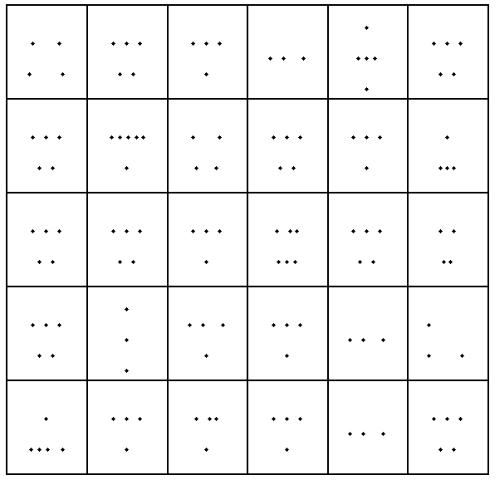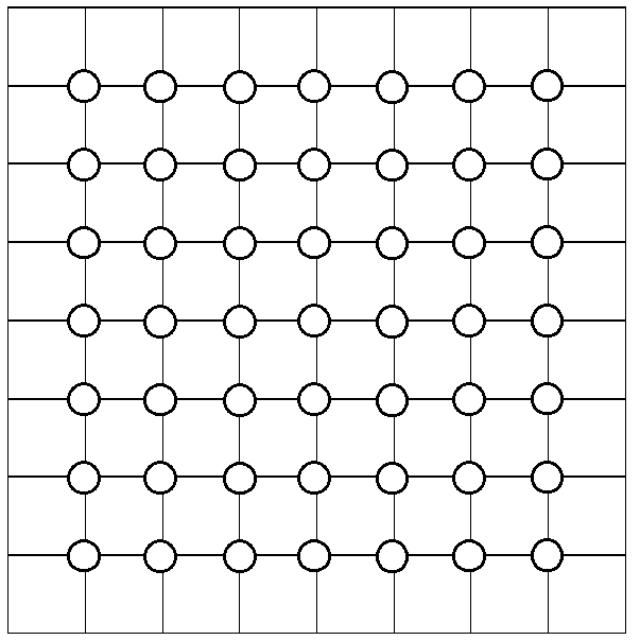UF/IFAS Nutrient Management Series: Soil Sampling Strategies for Precision Agriculture
The purpose of this fact sheet is to help identify different soil sampling strategies, and related advantages and disadvantages, if adoption of Precision Agriculture Technology is being considered.
Precision Agriculture promises to improve fertilizer use efficiency when fertilizer is applied in relation to needs identified by soil tests. Precision Agriculture technology aims at providing the ability to apply nutrients and other inputs for crop production at precise locations in the field, based on the soil test level at that location. Representative soil samples are the key to success of any nutrient management program because the analyses and the resulting nutrient recommendation will only be as good as the soil sample itself. Soil sampling assumes much greater significance when Precision or Site-specific Farming is adopted, because of the precision and representation required, the variable rates of nutrient calculation and application, and the economics of the technology as a whole. It is extremely important to consider the components of Precision Technology and assess their availability and management when developing a soil sampling strategy. The type of sampling scheme is also site-specific, depending on the factors involved and the goals set.
Soil Sampling and Factors to Be Considered
-
Purpose: The purpose of soil sampling should be clearly determined prior to beginning a detailed sampling of the area. If one or more of the components of Precision Farming Technology is not available, a traditional sampling and testing approach will probably provide just as much useful data, thus saving the time and money spent on developing a detailed sampling strategy.
-
Resolution: The high resolution obtained through a high intensity of samples from a given area may not always translate into useful and practical information. The optimum number of samples required from a particular field is often determined from the historical logs and experience of high- and low-yielding areas, areas with identifiable features like depressions, etc. Unless the information gathered from additional samples collected and analyzed can be directly used to improve management and profitability, an intensive sampling should not be attempted. A cost-benefit ratio should be worked out beforehand, because soil sampling and analyses costs can add up very quickly, thus diminishing the returns.
-
Affordability: Soil sampling needs should be assessed after considering the ability to absorb the costs through the initial startup funds, because the returns will not be available until after the harvest season and will depend on the market conditions. The sampling scheme may have to be tried or modified beyond a season or a year in order to evaluate and document the economic returns.
-
Data analyses: The data generated from the soil tests should be analyzed and interpreted with appropriate perspective that will reflect the site, cropping sequence, and resources available on the farm.
-
Treatment: A specialized soil sampling scheme should not be developed and implemented if the ability to treat and manage the respective field is lacking. This assessment is crucial, because if the means are lacking, all the gains from variable-rate fertilizer applications will not be realized.
-
Extra mileage: It is always helpful to gather information from a single soil-sampling trip because additional trips consume time and financial resources.
-
Confidence in the results: It is important to approach a soil test lab that has a record of consistently offering quality analyses. Similarly, access to fertilizer recommendations that are based on soil test interpretations for the soils and crop(s) to be grown should be evaluated. A high confidence in the results obtained is necessary because comparing the results and recommendations across different labs is strongly discouraged.
-
Soil properties: Soil samples can be obtained to analyze for both physical and chemical properties. A baseline on soil physical properties, like textural analysis, bulk density, permeability, hardpans, and depth to clay, can be obtained through a onetime assessment. Unlike soil chemical tests, it is not necessary to repeat a physical property test unless a soil amendment is added to ameliorate soil physical conditions like bulk density and hardpan. Field-scale alterations to physical properties like soil texture and depth to clay is not possible. Soil chemical properties include soil pH and extractable plant nutrient levels. Soil testing is recommended every season/year when Precision Technology is adopted for documenting improvements in soil pH and soil fertility levels.
-
Fertilizer recommendation: The key part of soil sampling and analyses is the fertilizer recommendation that accompanies each soil test report. This forms the basis for all the remaining activities involving inputs into the production cycle. Therefore, it is important to adhere to the rates of nutrients recommended. Altering the recommended rates on soil test reports for the sake of convenience will totally negate the benefits and may result in poor crop performance and economic losses.
-
Traditional soil sampling and testing: One consolidated sample for every 20-acre area that is uniform is recommended by most soil testing labs and consultants when traditional management methods, are employed. With traditional methods the recommendations are based on entire-field average and so the application of fertilizers is based on the averaged fertility level of the entire field, which is usually at one rate of fertilizer(s). Similarly the yield is averaged for the entire field.
Sampling Process
A base map of the field to be sampled should be constructed by collecting geo-referenced boundaries using GPS (Global Positioning System) equipment. The resolution of the GPS system being used will significantly influence the accuracy of the maps. After the Selective Availability (SA) has been turned off on May 1, 2000, typical GPS positioning error is about 30 ft. It is ideal if the GPS unit can detect distances 10 feet or less. DGPS (Differential Global Positioning System) provides better positioning accuracy (3–10 ft) and is typically used for soil sampling because precise positioning is required. Several computer software packages are available that can download the GPS data and overlay the boundaries on an aerial photograph of the field. A GIS (Geographic Information System) tool like ArcGIS is the most widely used software to draw maps based on geo-referenced information. This process should be repeated for all the sub-areas within the field with identifiable differences. This will enable input applications at variable rates within a field.
Sampling Schemes
Based on the shape and size of individual fields within a farm where crops are to be planted, suitable sampling schemes can be identified.
Grid Sampling
A checkerboard-type grid can be created using special ArcGIS and superimposed on the field map created. The grid approach works best when large tracts of land are available. While these shapes and sizes can be adjusted to suit the need and convenience, the most popular grid sizes used on the mid-western farms are either 2 1/2- or 2-acre grids. Even 1-acre grids are used on areas where a need for intensive sampling is identified. These fixed-area grids will therefore divide the field into equal square-shaped areas from within which samples will be collected. These square-shaped areas are also referred to as "cells."
A few important aspects of grid sampling must be well-understood before attempting to sample. Samples should be collected at random for adequate representation from within each grid and then consolidated. However, there are at least three methods of sample collection within a grid that are practical. One method is to go to the center of the grid with the GPS unit, walk several steps away from the center in all directions, collect samples from 3–5 spots randomly, and consolidate them (Figure 1). Being relatively simple, this grid-centered approach can be consistently done on any given field. However, for unbiased sampling, care should be taken to avoid concentration of samples around the center point. The second method is to collect samples at random from all across the grid without any bearing on the grid-center (Figure 2). The sampling pattern will not be consistent across the cells, but this approach will ensure a better randomization. This procedure may be more time consuming because various sampling points have to be individually accessed across the grid area. If random accessibility within the grids is severely restricted, samples should be collected diagonally across each cell. In either case the application rates will be uniform throughout each of the cells. The application rates can be varied only among the cells if necessary, depending on the nutrient recommendations.


The third method of grid sampling is to collect samples at grid line intersections (Figure 3). This approach will mathematically integrate the values (interpolate) between the points, which will enable creating contour maps based on the soil nutrient levels. The smaller the grid area chosen, the higher the sampling intensity, thus increasing the costs.

Directed Sampling
A self-directed sampling is another scheme that is often adopted. This method requires a prior knowledge of the site characteristics that may be limiting the yield. Once these low/high,yielding areas, soil types, areas under different cultural management, cropping systems, etc. are identified within a field, maps would be created to delineate the field accordingly and sampling would be conducted within these subregions. However, sampling based on factors that do not influence the yield should be avoided. This will effectively reduce the total number of samples.
Ability to respond to the needs determined from soil sampling and analysis should be the primary factor when designing a sampling scheme. If the capability to vary fertilizer rates and modify or amend the limiting factors is lacking, then the sampling intensity should be considerably reduced. Accruing additional information is expensive and can often cause confusion.
In order to obtain optimum returns, a Directed Sampling scheme developed in conjunction with a good assessment of available resources and the ability to apply nutrients at variable rates is highly recommended. Assessment will be most useful by considering the maximum area or Management Unit across which a fertilizer rate cannot be varied. A Management Unit will be a subunit of the entire field under consideration and representative samples should be randomly collected and composited for analysis. The results will then be averaged across this area, and applications will be made based on averages derived for this unit. Variations, if any, will be made among different units but not within any given unit. This process would be the most effective and economical of all.
A Strategy That Works
Precision, accuracy and reliability are the three main factors that will determine the success of any sampling scheme. Economic feasibility is, of course, the bottom line. The choices look simple, but may not always be easy to make. For this reason alone, help from professional consultants should be sought when Precision Agriculture is being considered.e purpose of providing specific information. UF/IFAS does not guarantee or warranty the products named, and references to them in this publication does not signify our approval to the exclusion of other products of suitable composition.



